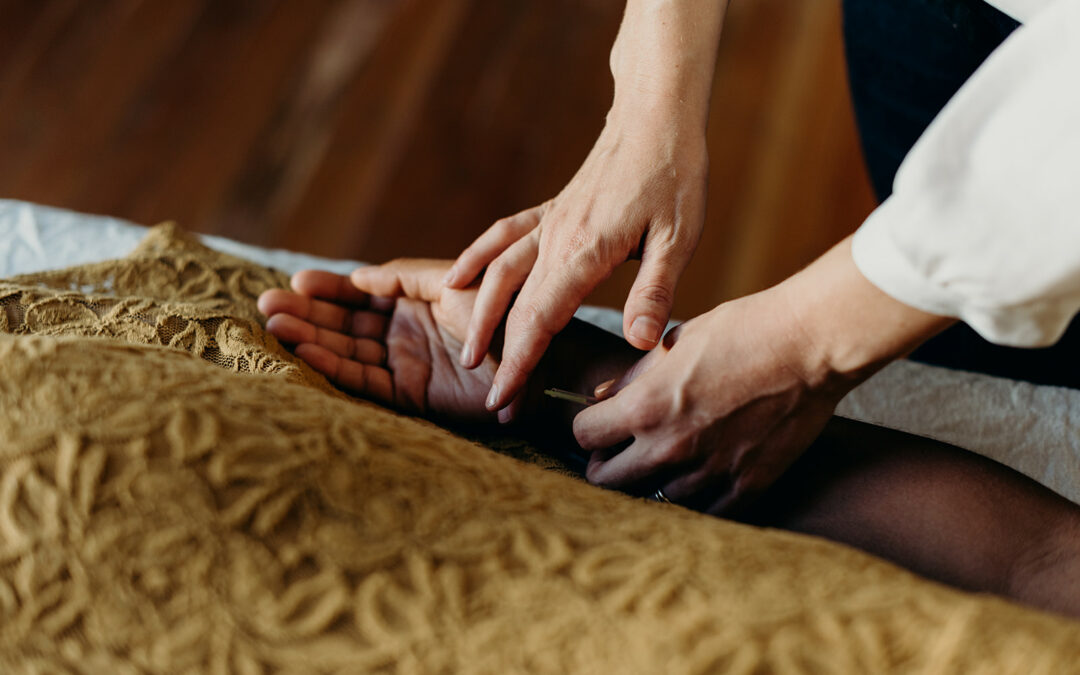How Many Acupuncture Sessions Do You Need Before You Feel Better?
Whether you’re an acupuncture newbie or you’ve been coming in for treatments for years, there’s a good chance you—like most people—have no clue how many acupuncture sessions it actually takes to heal your symptoms.
And what about after your symptoms have resolved? Do you know how often should you come in for acupuncture then?
This article will clarify:
- What does acupuncture do?
- Signs you need acupuncture and should book an appointment
- What’s a treatment plan?
- The 5 factors that can change the length of a treatment plan (aka how many acupuncture sessions you need)
- The average length of time it takes to see improvement in some of the most common conditions
- Maintenance and prevention: What to do after your symptoms have resolved
What does acupuncture do?
Acupuncture works by supporting the flow of Qi (aka Life Force Energy) throughout your body.
Treatments are cumulative, so while you will almost certainly feel better after each treatment, you have to come in regularly to enjoy lasting results.
One of your body’s biggest tasks—whether we’re talking about your bladder, nervous system, or left shoulder—is to maintain homeostasis.
Homeostasis happens when your body’s functions are balanced and relatively stable, and you know your body’s able to handle the workload when you feel good.
Acupuncture guides your body to maintain homeostasis more easily, and because the mind and body are treated as aspects of the same whole in Chinese medicine, patients who come in to treat physical symptoms often notice improvements in their mental health as well, and vice-versa.
But homeostasis is a big and complicated job.
There are innumerable moving pieces at play at any given moment.
Even something as simple and seemingly mindless as breathing requires the medulla oblongata in your brain to send regular rhythmical signals, your heart then has to pump, your blood has to be able to flow, your diaphragm to contract, your lungs to expand and absorb oxygen, then to relax and expel carbon-dioxide and other unneeded chemicals, and that’s just the simple version of what has to happen in order for you to breathe! 1, 2
The complexity of physiological processes means that there are plenty of opportunities for the natural healthy flow to be impeded.
Signs you need acupuncture and should book an appointment
You can know that qi isn’t flowing well and that your body is struggling to maintain homeostasis anytime you don’t feel good.
Most people come to acupuncture to help with pain, but because Chinese medicine is holistic, acupuncturists are able to treat any symptom of imbalance that presents in the body or mind.
Some of the most common conditions we see in clinic include:
- Headaches and migraines
- Digestive irregularity, including acid reflux/GERD, gas, bloating, constipation, diarrhea/loose-stools, abdominal discomfort, nausea, and IBS
- Sinus issues and allergies
- Insomnia
- Fatigue, low energy, foggy-brain
- PMS, menstrual pain, menstrual irregularity
- Menopausal symptoms
- Chronic stress, anxiety, mood swings, irritation
- Musculoskeletal pain, injuries, body aches
- And other symptoms of imbalance
Basically, if you don’t feel your best and aren’t able to show up for life the way you want to, it’s time to book an acupuncture appointment.
What’s a treatment plan?
When you come acupuncture with a specific complaint, your acupuncturist will come up with a treatment plan for you with a rough estimate of how many sessions you will need before you can expect to see sustainable improvement and move on to the maintenance/prevention phase.
The length of a treatment plan varies. Every body is different, life is unpredictable, and people respond to acupuncture treatments in different ways.
But generally speaking, most conditions will have improved or be resolved after 6-12 weekly or biweekly treatments on average.
The 5 factors that can change the length of a treatment plan (aka how many acupuncture sessions you need)
The amount of acupuncture sessions you need changes based on 5 factors.
1. Your treatment plan will be longer if the condition is chronic
If you’ve been dealing with this symptom for a while, your body has become accustomed to doing things a certain way and it will generally take longer to “teach” it a new, healthier pattern.
More acute issues (like those that started one to two weeks ago) generally haven’t had time to set into a pathological pattern yet, and are more likely to fully resolve with just a few consistent treatments.
2. Age and immunity affect healing time
Older bodies and immune-compromised bodies generally take longer to heal.
3. Inconsistent symptoms resolve more quickly than more stable conditions
If your symptoms come and go, or they frequently change in quality or intensity, you’ll probably notice results faster than if your symptoms have been stable for an extended period of time.
For example, if your knee pain is sharp sometimes, dull other times, comes and goes randomly and only gets in the way of your daily activities once a month, you probably won’t have to come in for as many treatments as someone who consistently has to shorten their walks because knee pain is too much after they’ve walked half a mile.
4. If initial improvement is slow, the treatment plan will take longer
Taking the above 3 conditions into consideration, your acupuncturist should be able to give you a ballpark range for what to expect in terms of a long-term treatment plan.
That said, if it takes longer than expected for you to notice improvement, it will probably take longer for the improvements to reach a point of sustainability and your acupuncturist might extend your treatment plan as a result.
If this happens to you, don’t give up!
It can be frustrating when healing is slow—we all want fast results—but the great thing about natural medicine modalities like acupuncture is that they work with the body’s innate ability to heal instead of just covering up symptoms. This means that there are less side-effects and longer-lasting results than most treatment options from conventional western medicine.
5. You have to do your part
If your acupuncturist tells you that you need to come in twice a week for 4 weeks for maximum benefit, but you only come in every other week, don’t be surprised if you find yourself 10 weeks into treatment without the major changes you were hoping to see.
Similarly, if lifestyle or diet are contributing to the symptoms but you don’t make the changes your acupuncturist recommends, treatments will only go so far.
How many acupuncture treatments do you need on average?
It’s clear that there are a lot of factors that contribute to the length of a treatment plan, and they affect when you can expect to see noticeable improvements in your symptoms.
That said, the type of condition you’re coming in for also plays a role in how many acupuncture treatments you will need.
Dr. Katherine Altneu conducted a survey of more than 180 acupuncturists to find out how long it took for them to see improvement for various conditions.
Here are the average number of weekly or biweekly (twice a week) acupuncture treatments needed for some of the most common conditions:
Acute back pain: 3-4 treatments
Chronic back pain: 8-10 treatments
IBS/Digestive symptoms: 6-8 treatments
Migraine headaches: 8-10 treatments
Non-migraine headaches 4-6 treatments
Fatigue: 8-10 treatments
Insomnia 8-10 treatments
Menstrual symptoms: 8-10 treatments
Menopausal symptoms: 8-10 treatments
Anxiety and depression: 8-10 treatments
Chronic injury or pain: 10-12 treatments
Acute injury or pain: 3-4 treatments
Fertility: 5 months
Allergies 6-8 treatments
Remember, acupuncture effects are cumulative.
To see lasting results, you want to come in at least once or twice a week until improvements have stabilized. Once you’ve reached a comfortable point, that’s when you can taper off to every other week and then monthly treatments.
If you leave too much space between treatments when you’re actively trying to resolve an issue, you may not get the results you’re hoping for.
Maintenance and prevention: What to do after your symptoms have resolved
Right along with diet and exercise, acupuncture is part of a healthy lifestyle.
Once symptoms have resolved, most people find it beneficial (not to mention just plain lovely!) to come in for monthly “tune-ups”, or maintenance sessions.
You can think of Qi as a flowing river, and acupuncture helps to shape the riverbed so the river of your health and life can flow more smoothly, making it less likely for future imbalances to arise.
With regular maintenance sessions you tend to heal more quickly. So if there’s ever a flare-up or you injure yourself, you’ll only have to book a few extra appointments before you’re good to go again.
Ready to find out what acupuncture can do for you? Has it been more than a month since you’ve been in?
Then it’s time to book your next session! Call now to schedule a session with Katerina: (503) 372-6463
We look forward to treating you!





